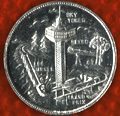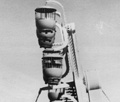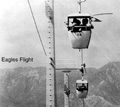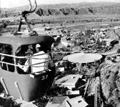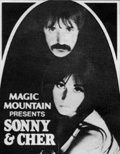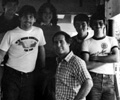|
|
Sonny & Cher, 1971
Magic Mountain | Valencia, California
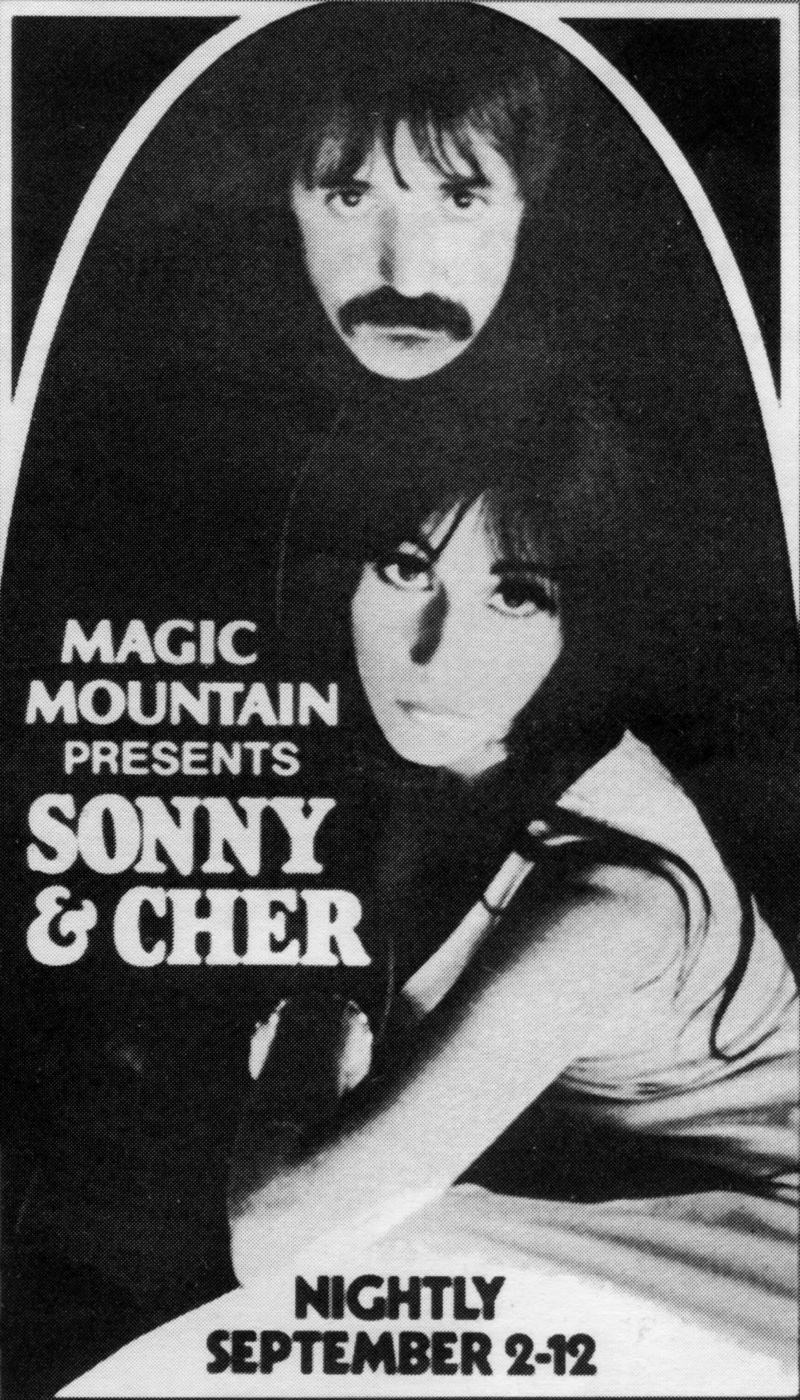
Click image to enlarge Pop stars Sonny & Cher performed nightly from Sept. 2-12, 1971, at Magic Mountain's 7-Up Showcase Theatre (later called the Golden Bear Theater). Magic Mountain was no slouch when it came to booking top acts. Sonny & Cher were big stars; earlier in 1971, "The Sonny and Cher Comedy Hour" debuted on CBS as a summer replacement series. It lasted four seasons and garnered 15 Emmy nominations. And the Santa Clarita Valley wasn't exactly unfamiliar territory. Not only did Sonny & Cher own property in the SCV; Cher was also the great-granddaughter of Placerita Canyon homesteader Frank Walker, and she visited her grandparents there as a child. Further reading: Sonny & Cher Bono's Placerita Canyon Property.
About Magic Mountain. In 1968, executives of Sea World Inc. were looking for a place in Los Angeles County to build a new theme park. Knowing that The Newhall Land and Farming Company had enough undeveloped land and that the company wanted to attract attention to its New Town of Valencia, a county planner asked company CEO James F. Dickason if he was interested. He was. After intense negotiations, Sea World and Newhall Land formed a $20 million partnership and began to build a 200-acre amusement park at the western edge of Valencia. Seventy acres would be used for the park itself — rides, theaters, games, food, landscaping — and the rest for parking and ancillary services. Headed by general contractor J.M. Brock & Sons of Los Angeles, construction began Nov. 17, 1969, and continued until opening day. Brock was building homes in Valencia at the same time. When Magic Mountain's wrought-iron gates swung open to the general public for the first time on May 29, 1971, Southern California's most exciting "white knuckler" experience was the Gold Rusher roller coaster, which careened over the hillsides on its distinctive gold-colored track at a breathtaking 35 miles per hour. Highlights of the day were El Bumpo, a bumper boat ride where patrons navigated gas-powered skimmer craft over a lagoon; Galaxy, a giant, double-armed tilting Ferris wheel; Billy the Squid, a brightly colored ride with huge, revolving tentacles; and the Log Jammer, a flume ride. A favorite centerpiece was the Grand Carousel, which traced its history to 1912 and underwent a $300,000 refurbishment for a new spin at life. Linking everything together was a monorail system designed and built by Universal Mobility Inc. of Salt Lake City — and a maze of contoured walkways developed by Strecker Construction Co. of Santa Fe Springs. By the numbers, the 1971 admission price was $5 (just $3.50 for kids 12 and under). The park boasted 500 employees and featured 33 rides, many of which were built by the Swiss firm Intamin AG (Sky Tower, Galaxy, Funicular) and Arrow Dynamics (Gold Rusher, Log Jammer, Grand Prix, El Bumpo). Arrow Dynamics, a Bay Area roller coaster and amusement ride design company partially owned by Walt Disney, had a number of popular Southland attractions to its credit including the Matterhorn Bobsleds at Disneyland and the Corkscrew at Knotts Berry Farm. Installation of the Sky Tower fell to the Los Angeles firm of Aggressive Erectors & Bridgemen Inc., which used a crane with a 330-foot boom to lift the observation platform into place. Aggressive also helped set up Billy the Squid, the Circus Wheel, the Crazy Barrel and Bottoms-Up. J.A. Placek Construction of Torrance built the Funicular's cable railway. Magic Mountain lured a remarkably rich lineup of entertainers to its 7-Up/Dixi Cola Showcase Theatre (later known as the Golden Bear Theater) including Barbra Streisand, Bill Cosby, Jimmy Durante, Phyllis Diller, Pat Boone, the Carpenters, Connie Stevens, Mac Davis and Sonny & Cher. In 1978, the rock group KISS used Magic Mountain as the setting of its horrid made-for-TV movie, "KISS Meets the Phantom of the Park" — which became something of a cult classic, even though band members are said to have forbidden roadies from ever mentioning it. Rumors of an acutal phantom that appeared atop hills and caused rides to turn on mysteriously after midnight persisted. Film-goers seemed happier with "National Lampoon's Vacation" (1983), when the park doubled for Walley World. In 1971, the park had secured rights from Warner Bros. to use its Looney Tunes characters. If Disneyland had Mickey Mouse, Magic Mountain would have Bugs Bunny. But it was a short-term deal, and after the inaugural year, the Warner Bros. characters stayed away for more than a decade. So in 1972, Magic Mountain introduced its own lineup of memorable characters — Bloop, Bleep, King Troll (aka King Blop) and the Wizard — accompanied by a colorful wardrobe change for park attendants. Replacing the first-year garments from Imperial Costumes of Dallas were new uniforms designed by Academy Award winner Mary Wills. They came in "Canyon Gold," "Pine Green" and "Valencia Blue." Initially the costumed entertainers were union laborers provided through All King Productions, a member of American Guild of Variety Artists; after All King's contract expired Dec. 31, 1972, Magic Mountain brought the entertainment in-house with non-union workers. Troll pay fell to $2.75 per hour from $3.50; at the time, the minimum wage was $1.65. At least one notable park employee who wore the Bleep costume would go on to make a name for herself — Oscar nominee Debra Winger ("Urban Cowboy," "An Officer and a Gentleman," "Terms of Endearment," "Legal Eagles," "Shadowlands"). The actress remembers that it was between Christmas and New Year's in 1972 when she sustained a serious on-the-job injury. Seventeen-year-old Debra was being driven to a location in the park in a Cushman vehicle when she "went out the back end, in costume." According to news reports, she was partially paralyzed and temporarily blinded. Her recovery took many months. (Incidentally, she remembers that Bloop was a nice guy.) Debra's older brother, Marc, would become superintendent of the Newhall School District. Perhaps the incident was an omen of things to come. The 1970s were puncuated with injuries to park employees and patrons alike, all too frequently resulting in death. In January 1978, Theron "Terry" Fowler, a Grand Prix mechanic, died when one of the cars fell on top of him. A 1969 Hart High graduate and an aspiring teacher, Fowler's body was discovered the next morning — by his own father, who had gone to look for him. The following month, on Feb. 5, 1978, a pair of newlyweds were violently rocking the Eagles Flight sky ride, causing their bucket to plunge 50 feet to the ground. The husband died and the young bride sustained critical injuries. On December 26 of that same year, 20-year-old Carolina Cynthia Flores of East L.A., whose girth should have prohibited her from riding the brand-new Colossus roller coaster, was not securely fastened into her seat; she flew out. Next, an 8-year-old child was maimed when he somehow got dragged under the Dragon ride — a low-slung people mover that slowly ferried patrons up the hill to the Sky Tower and Magic Pagoda. Each incident led to dramatic changes. Following Fowler's death, supervisors were required to check employee time cards to ensure they'd punched out at the end of their shift. The Dragon was removed in 1981, as was one of the two separate Eagles Flight courses. Safety features were added to the remaining course, and it, too, was eventually removed. Colossus went through three generations of trains; ultimately they were so secure that in 1984, patrons were invited to ride backward. Understandably, The Newhall Land and Farming Co. wanted out of the theme park business. It was in the business of entitling and selling land, not holding it and operating unrelated companies on that land. Magic Mountain had done its job by putting Valencia on the map. Newhall Land was ready to divest. In 1979, Newhall Land sold the park to Six Flags for $51 million, a profit of just $250,000. At the time, Six Flags operated five other parks around the country and was a subsidiary of the Pennsylvania Railroad. In 1982 the chain was sold to Bally Corp., which sold it for $350 million in 1987 to Wesray Corp., an investor group headed by former Treasury Secretary William E. Simon. Meanwhile, Time Warner increased its ownership position in Six Flags from 19.5 percent in 1990 to 50 percent in 1991. Time Warner's influence eradicated the last vestiges of the unique indentity Newhall Land had stamped on the park in the 1970s. Not only had Bugs Bunny and his cohorts replaced Bloop and Bleep by 1985; gone, too, was the "Western" theme embodied in the Grand Centennial Excursion, whose trains carried visitors from a ghost mining camp through an actual buffalo corral (actually American bison), past a lake with migratory Canadian geese, to the old-timey Spillikin Corners, an arts-and-crafts section where guests could watch trained artisans make candles, candy and more. (The geese flew away when the lake was removed; at first they wintered on another manmade lake at the nearby Valencia Lakeshore condominiums. The present writer can't recall what happened to the bison herd. The old Spillikin Corners water wheel ended in the garden in back of Le Chêne Restaurant on Sierra Highway.) Time Warner retained a dominant position as Six Flags went through additional ownership changes and gobbled up more theme parks in the U.S. and abroad. Time Warner emboldened its branding at Magic Mountain with the Batman Stunt Show in 1992, followed in 1994 by Batman The Ride. Superman and other Warner Bros. characters were close behind. Six Flags' expansion came to an abrupt halt in 2004 when the company started to shutter and sell properties to alleviate its mounting debt. Creditors including Bill Gates, who owned 11 percent, were unhappy, and Hurricane Katrina (2005) didn't help. By 2008, the New York Stock Exchange was threatening Six Flags with delisting. The company filed for Chapter 11 bankruptcy protection June 13, 2009, and emerged May 3, 2010, with new management and restructured debt. Six Flags had put Magic Mountain and its water-themed neighbor, Hurricane Harbor (1995), on the block in 2006 but couldn't find a suitor and ultimatly decided to keep them. The twin parks, known collectively as Six Flags California, were profitable even as the parent company was bleeding money elsewhere. To Santa Claritans, the troubles seemed distant. Through it all, from an annual attendance of 1 million in 1971 to roughly 3 million today, Magic Mountian remained king of the coasters, rivaled only by Cedar Point, Ohio, in a back-and-forth trade-off for the distinction of having the tallest, fastest — and above all, the most — roller coasters in a single park. Since 1971, the Six Flags California parks have consistenly employed more Santa Clarita Valley residents than any other company. It's good to be the king, but it is the king's subjects — a long line of young adults, usually on their first job — who deserve the lion's share of credit for creating more than 40 years of on-the-ground experiences that have kept happy customers coming back year after year.
Sources: Six Flags California; "A California Legend: The Newhall Land and Farming Company" by Ruth Waldo Newhall (1992); Dr. Marc Winger and Debra Winger (personal information); Nanette Lagasse Gaither (Terry Fowler information); Patrick Comey (All King Productions information); L.A. Times Advertising Supplement (1971, courtesy of Tony Newhall); Six Flags Magic Mountain 25th Anniversary Memory Book (1996, courtesy of Sandy Renshaw Sinner); various financial statements and reports.
SR9608: 9600 dpi jpeg from printed material ("Six Flags Magic Mountain 25th Anniversary Memory Book," 1996), borrowed from Sandy Renshaw | Online image only | Archival scan on file |
Pre-Opening Brochure
Grand Opening
Preview Night Ticket
L.A. Times Supplement 6/13/1971
1971 Wall Map (Color)
1971 Map
1971 Medal
Porcelain Plate Early 1970s
Fountain & Valencia Falls ~1971
Gold Rusher
Log Jammer ~1971
El Bumpo
Galaxy
Galaxy
Eagles Flight
Eagles Flight
Circus Wheel ~1971
Jet Stream 1972
Sonny & Cher
Variety Show 1970s
Clown Coaster 1974
Accordion Player 1974
Revolution 1976 (1990s)
Goats 1974
Family Visit 1976 (Mult.)
Western Airlines
Sky Tower 1977-78
KISS Meets Phantom (1978)
National Lampoon's Vacation (1983)
Vincent Price on Jet Stream ~1985
Fact Sheet: Shock Wave 1986
MORE:
|
The site owner makes no assertions as to ownership of any original copyrights to digitized images. However, these images are intended for Personal or Research use only. Any other kind of use, including but not limited to commercial or scholarly publication in any medium or format, public exhibition, or use online or in a web site, may be subject to additional restrictions including but not limited to the copyrights held by parties other than the site owner. USERS ARE SOLELY RESPONSIBLE for determining the existence of such rights and for obtaining any permissions and/or paying associated fees necessary for the proposed use.






